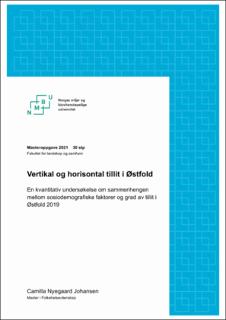| dc.contributor.advisor | Ihlebæk, Camilla | |
| dc.contributor.author | Johansen, Camilla Nyegaard | |
| dc.coverage.spatial | Norway, Østfold | en_US |
| dc.date.accessioned | 2021-10-25T13:38:05Z | |
| dc.date.available | 2021-10-25T13:38:05Z | |
| dc.date.issued | 2021 | |
| dc.identifier.uri | https://hdl.handle.net/11250/2825450 | |
| dc.description.abstract | Bakgrunn: Tillit som en del av sosial kapital er et viktig fundament for et helsefremmende og velfungerende samfunn. Til tross for at det i Norge generelt er høye nivåer av tillit og relativt små sosiale ulikheter i befolkningen, er det tidligere funnet forskjeller mellom ulike sosioøkonomiske grupper i grad av tillit. Det er derfor behov for mer kunnskap om nivået av tillit hos befolkningen, og hvordan tilliten fordeler seg.
Formål: Å undersøke både grad av tillit til institusjoner (vertikal tillit) og generell tillit (horisontal tillit) i et utvalg av befolkningen i Østfold. Videre var et mål å undersøke om demografiske og sosioøkonomiske faktorer var assosiert med grad av tillit.
Metode: Det ble benyttet data fra tverrsnittstudien ”Oss i Øsfold 2019” utført av Østfold fylkeskommune, med et representativt utvalg (n=16 558) av befolkningen i Østfold i alderen 18-79 år. Assosiasjonen mellom de sosiodemografiske variablene kjønn, alder, utdanning og opplevd økonomisk situasjon, og grad av tillit, ble undersøkt ved hjelp av logistiske regresjonsanalyser. Institusjonene som ble undersøkt var helsevesenet, skolevesenet, NAV, kommunestyret, politiet, rettsvesenet og massemedia. Forskjeller mellom gruppene ble oppgitt ved odds ratio (OR).
Resultater: For utvalget som helhet var helsevesenet den institusjonen flest hadde høy tillit til (83.0 %), mens færrest hadde høy tillit til massemedia (42.9 %). Det var 65.9 % av utvalget som oppga at de generelt hadde høy tillit til andre mennesker. Funnene viste at det var klare sosiodemografiske forskjeller i grad av tillit. Kvinner hadde høyere tillit til institusjoner og høyere generell tillit enn menn. Den generelle tilliten økte med alderen. Funnene viste også at utdanningsnivå og opplevd økonomisk situasjon var positivt assosiert med grad av både institusjonell- og generell tillit.
Konklusjon: Det ble funnet en klar sosial gradient i forekomst av både vertikal og horisontal tillit. Dette er viktig å ta på alvor, da økende grad av mistillit kan føre til en utvikling som undergraver demokratiske verdier, og svekker den generelle viljen i samfunnet til å slutte opp om kollektive velferdsordninger. I Østfold kan det være behov for å ha et bevisst forhold til tillitsbyggende arbeid, for å generere sosial kapital som en viktig ressurs i samfunnet. Det bør fokuseres på strategier som sikrer høy sysselsetting, rettferdig inntektsfordeling og gode velferdsordninger. I tillegg, kan det være behov for målrettede tiltak mot grupper med lav sosioøkonomisk posisjon. | en_US |
| dc.description.abstract | Background: Trust as a part of social capital is an important foundation for a healthpromoting and well-functioning society. Even though there are generally high levels of trust in Norway and relatively small social inequalities in the population, differences between socio-economic groups in levels of trust have been found in previous research. There is therefore a need for more knowledge about the levels of trust among the population, and how trust is distributed.
Aim: To study the levels of trust in public institutions (vertical trust) and general trust (horizontal trust) within a representative sample of the population in Østfold aged 18-79 years. Furthermore, examine whether demographic (gender and age) and socioeconomic (education level and economic situation) factors are associated with levels of trust.
Method: Data from the cross-sectional study ”Oss i Østfold 2019”, conducted by the county municipality Østfold was used, with a representative sample (n=16 558) of the population of Østfold. Logistic regression analyses were used to examine whether the sociodemographic variables gender, age, education and perceived economic self-sufficiency were associated with levels of trust. The institutions examined were the healthcare system, the school system, NAV (Social Security office), the municipal council, the police, the legal system and the media. Differences between the groups were measured using odds ratio (OR).
Results: Overall, the majority in the sample had high levels of trust in the healthcare system (83.0 %). Fewest in the analysed sample had high levels of trust in the media (42.9 %). 65.9 % of the sample reported high levels of general trust in other people. The findings showed significant sociodemographic factors in terms of trust. The women in the study had higher institutional and general trust, than the male participants. Horizontal trust increased with the age. Education level and perceived economic self-sufficiency were positively associated with the degree of both institutional trust and general trust.
Conclusion: A clear social gradient was found in the incidence of both vertical and horizontal trust. It is important to take this seriously, as an increase of distrust can lead to a development that undermines democratic values and reduces the general will in society to support collective welfare schemes. In Østfold there may be a need for a conscious approach to trustbuilding work, in order to generate social capital as an important resource in society. Strategies that focus on high employment, economic equality and good welfare schemes should be in focus. In addition, these findings may imply that targeted measures to build trust in low socio-economic groups are needed. | en_US |
| dc.language.iso | nob | en_US |
| dc.publisher | Norwegian University of Life Sciences, Ås | en_US |
| dc.rights | Attribution-NonCommercial-NoDerivatives 4.0 Internasjonal | * |
| dc.rights.uri | http://creativecommons.org/licenses/by-nc-nd/4.0/deed.no | * |
| dc.title | Vertikal og horisontal tillit i Østfold : en kvantitativ undersøkelse om sammenhengen mellom sosiodemografiske faktorer og grad av tillit i Østfold 2019 | en_US |
| dc.title.alternative | Vertical and horizontal trust in Østfold 2019 : a quantitative study of the relationship between sosio-demographic factors and levels of trust in Østfold 2019 | en_US |
| dc.type | Master thesis | en_US |
| dc.description.localcode | M-FOL | en_US |

